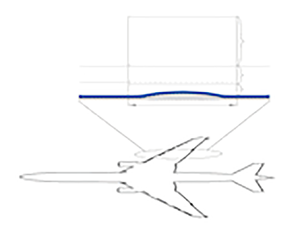Published online by Cambridge University Press: 06 June 2022

This work is concerned with the laminar–turbulent transition in the boundary layer on an aircraft wing covered by a water film. We consider the initial stage of the transition process known as the receptivity of the boundary layer, namely, we study the generation of the interfacial instability waves by the unsteady free-stream acoustic noise interacting with a small roughness on the wing surface. For effective receptivity, the ‘forcing’ should obey the so-called ‘double-resonance’ principle. According to this principle, both the frequency and the wavenumber of the external perturbations should be in tune with the natural instability modes of the flow. Correspondingly, we choose the frequency of the acoustic wave to coincide with that of the interfacial instability wave. However, this makes the wavelength of the acoustic wave significantly larger than wavelength of the instability wave. Thus, the second resonance condition is not satisfied, which means that the acoustic wave alone cannot produce the instability waves in the boundary layer. Instead, the Stokes layer is created in the boundary layer just above the liquid film. As far as the film is concerned, it also experiences wave-like motion caused by the varying shear stress on the interface. The generation of the interfacial instability waves takes place when the Stokes layer encounters a wall roughness that is short enough for an appropriate scale conversion to take place. To describe the flow in the vicinity of the roughness, a suitably modified triple-deck theory is used.